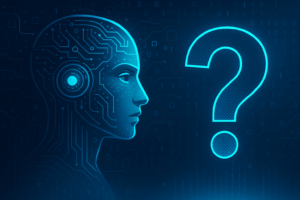The rapid evolution of artificial intelligence (AI) has sparked a global debate over how best to regulate this transformative technology. With the European Union’s AI Act already enacted and the United States moving forward with proposed legislation, the urgency to shape responsible AI governance is intensifying.
Building on the theme of “Sanctioned AI,” this article explores the current landscape of AI regulation, evaluates the balance between innovation and oversight, and asks the critical question: who is truly steering the future of AI?
🌍 Why It’s Timely
The EU AI Act, passed in 2024, is a first-of-its-kind legal framework that categorizes AI systems by risk and imposes strict requirements on high-risk applications like facial recognition and autonomous vehicles. This proactive legislation prioritizes privacy, safety, and fundamental rights.
🔗 Read: EU AI Act Summary – European Parliament
🔗 Explore: Full Overview – ArtificialIntelligenceAct.eu
In the United States, lawmakers introduced the proposed AI Safety and Accountability Act of 2025, aimed at creating a federal framework for AI safety assessments, transparency, and accountability. Though still under consideration, the bipartisan support signals growing alignment on the need for national standards.
Together, these efforts show how legal frameworks are beginning to define what constitutes “approved” or “ethical” AI.
✅ The Case for Regulation
1. Mitigating Risk
Unchecked AI can amplify societal harms, from algorithmic bias in hiring to surveillance overreach. The EU’s risk-tier system ensures that sensitive AI undergoes rigorous testing before deployment—building public trust.
2. Establishing Global Standards
Clear regulations can harmonize international AI practices and prevent a “race to the bottom,” where safety is sacrificed for speed. U.S. efforts aim to set benchmarks that companies and consumers can rely on.
3. Driving Responsible Innovation
Regulations can create safe boundaries for innovation, especially in sectors like healthcare, where ethical standards are crucial. Guardrails can push developers toward creating AI that aligns with human values.
⚠️ The Case Against Regulation
1. Slowing Innovation
Compliance with detailed regulations—especially in the EU—can delay product development, disproportionately affecting startups and smaller firms without deep legal or technical resources.
2. Overregulation Risks
Excessively rigid laws may discourage exploration of emerging AI technologies. Critics argue the proposed U.S. bill could create bureaucratic obstacles, potentially giving an edge to less-regulated markets like China.
3. Fragmentation
Without global coordination, developers face a patchwork of regulations, increasing costs and complexity in international deployment.
🏛️ Self-Regulation vs. Government Oversight
Major tech companies have taken steps toward self-governance by creating internal ethical guidelines and AI standards:
These frameworks often include transparency tools, AI ethics boards, and algorithmic fairness commitments. However, because these standards are voluntary, there’s concern that they may prioritize corporate interests over public good.
A hybrid approach—where governments provide legal safeguards and companies innovate within ethical bounds—may offer the best of both worlds.
📊 Who Regulates AI? A Global Comparison
| Entity / Region | Approach | Regulation Status | Key Features | Risks / Challenges |
|---|---|---|---|---|
| European Union | Government-led | ✅ Enacted (2024) | Risk-based tiers, bans on harmful AI, human rights focus | Compliance costs, potential innovation delays |
| United States | Proposed federal framework | ⚠️ In progress (2025) | Transparency requirements, safety assessments, bipartisan backing | Uncertainty, potential industry resistance |
| China | State-driven, top-down control | ✅ Enforced in stages | Mandatory registration, AI-generated content controls, algorithm audits | Opacity, government overreach |
| Microsoft / Google | Corporate self-regulation | ✅ Voluntary standards | Ethics boards, fairness guidelines, internal audits | Lacks enforceability, public accountability concerns |
🔮 What’s at Stake?
At the core of this debate lies a powerful question:
Who should steer the future of artificial intelligence—governments, companies, or both?
Advocates for regulation point to the success of past efforts like the GDPR, which set a global bar for data protection. Others warn that overly restrictive policies could drive talent and capital to less-regulated regions, giving rise to “AI havens” with fewer safeguards.
A balanced regulatory approach might include:
- Tiered rules based on use case and maturity level
- Public-private partnerships for policy shaping
- Global coordination to reduce fragmentation
- Incentives for ethical AI design and testing
🧭 Conclusion
AI regulation is no longer a theoretical debate—it’s happening now. The EU’s comprehensive AI Act and the U.S. proposed legislation mark significant steps toward shaping a responsible AI ecosystem.
Whether through legal frameworks, corporate codes of conduct, or international agreements, the future of AI governance hinges on one challenge: creating policies that protect society without stifling progress.
The path forward is complex, but one thing is clear—the rules of the AI era are being written today.
For the latest developments, follow credible sources like the OECD AI Policy Observatory and official government releases. This article reflects the regulatory landscape as of June 10, 2025.




